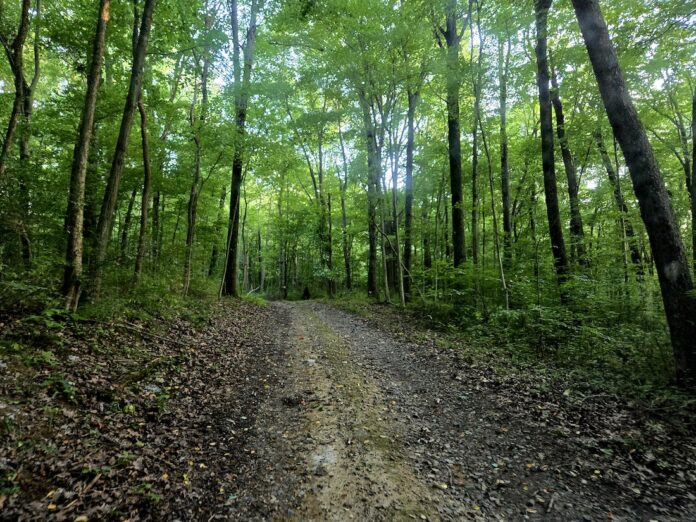
I sat on the tailgate of the farm’s Kawasaki Mule, enjoying what was left of the sunshine. It’s a gorgeous summer evening, a Friday night. The weekend was beginning. My farm dog, Kali, lounged in the grass nearby as I contemplated my next task.
Among all the other items on my daily farm chores to-do list, I need to euthanize a ram lamb that was stricken with meningeal worm.
I’m stalling. Normally, euthanizing an animal is a quick and tidy affair once I decide it needs to be done. When it gets to that point, the aim is to limit the animal’s suffering as much as possible. Doing this is tough, but this one especially so.
This lamb has been down since Monday or Tuesday, unable to use his back legs, but otherwise, he’s perky. He’s eating and drinking, at least as well as he can from the ground.
That’s the insidious thing about meningeal worms. By the time discernible symptoms appear, it’s usually too late. There’s no test to verify that it’s this particular parasite. You just have to know the symptoms, know your sheep and know the treatment. If you catch it soon enough and treat it aggressively, there’s a chance you can kill the worms, stop the progression of the symptoms and bring the animal back to full health. I’ve done it twice, by some miracle. But if you miss that window, the damage is done and it’s irreversible.
I had just gotten back from a week-long vacation with my husband when my mother-in-law texted me that this ram lamb was down. I knew then I’d missed that window already.
The meningeal worm’s primary host is the white-tailed deer, which we have an overabundance of on our farm. The worm reproduces in the deer and gets passed through its feces. Snails or slugs pick up the larvae. Then sheep pick it up from the snails or slugs or their slime in the grass.
It’s easy to be mad at the deer, but I remind myself that it’s not their fault. They are simply existing in a space that used to be all their own only a few hundred years ago. In fact, the spaces we created by clearing the forests to raise our crops and our livestock may be even better than what they had before. Who can blame them for being here.
I dragged the ram lamb out of the barn to find hard ground to see if he could stand. He deserved one last chance. He got his front legs under him and sat up straight like a dog. But his back legs wouldn’t work the way he wanted them to so he lay back down. I carried him over to the grass outside the barn so he could eat a bit before I shot him in the head.
The other option was to continue feeding him and giving him water while he lay there in the barn, hoping he’d recover. Maybe he would get up, but probably not. Recovery comes quickly, if at all. I dewormed him hard enough on Wednesday that I probably killed the worms, but it was too late. He was not suffering badly right now, but it wouldn’t be long before he was. A sheep can’t live lying down. It’s not good for them. He needed to be able to move under his own power with his flock mates as they roamed each new paddock to find fresh grass.
There’s a saying among some farmers: “Our animals only have one bad day.” That one bad day is the last one they spend going the butcher shop before they’re killed. The process of dying there is quick and painless, as I understand it. It’s the stress of being transported to the shop and existing in an unfamiliar place beforehand that’s the bad part.
I like to believe that, but I know it’s not entirely true. Animals can get sick or injured. They experience stress at weaning time or when the weather turns violently to blazing hot or freezing cold. But we try to limit their suffering as much as possible. Suffering is bad for business, but it’s also bad for the soul. These animals are living beings who deserve some amount of dignity.
I could prop this lamb up until he died a “natural” death, however fast or slow that would happen. But a natural death is rarely a humane one. And it’s up to us as farmers to know when and how we can limit that suffering, even if it’s hard on our hearts.
I loaded the .22 and gave the lamb some sweet feed. It’s harder to kill an animal that’s still perky, so I want him to be distracted. I told him sorry and thank you. I drew an X on the top of his head, between his ears and eyeballs, and I pulled the trigger.
I loaded his body into the bed of the Mule and drove him up into the woods to where we compost deadstock. The sun peeked through the trees as it set over the hill, coloring everything a warm red. Kali rode beside me on the buggy, sniffing the breeze.
I still had to clean and refill water troughs, feed the dogs and top off mineral feeders. But this job was done.














Thoughtful and accurate. Something’s are hard to dress up. Life has its realities and you have shown a truth. Farming has good days and bad. Thanks for sharing what many of us have experienced in different ways.